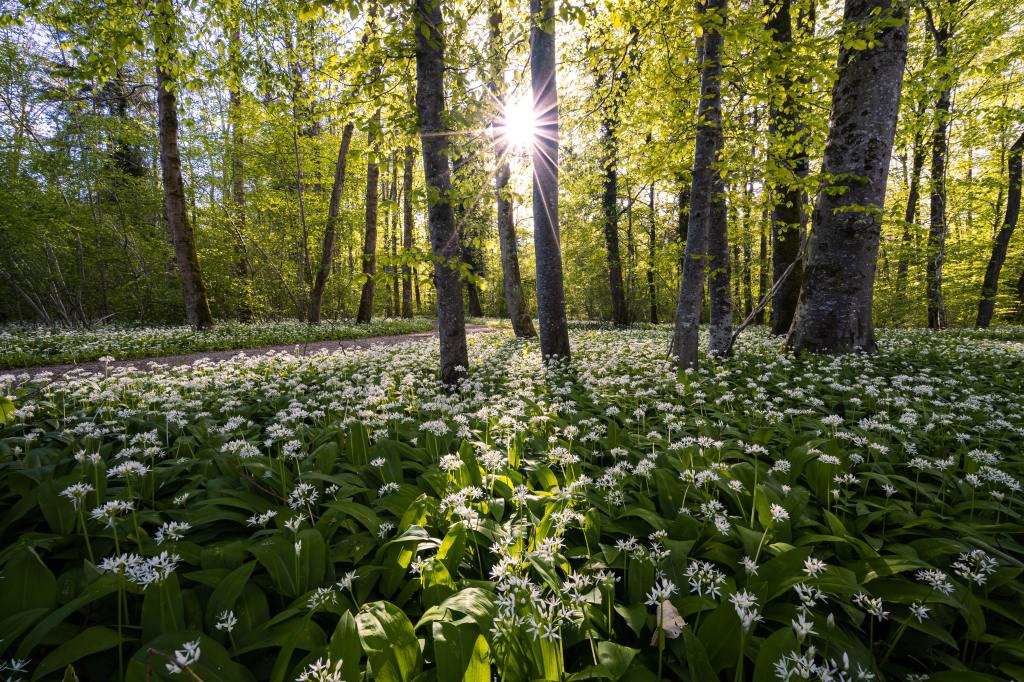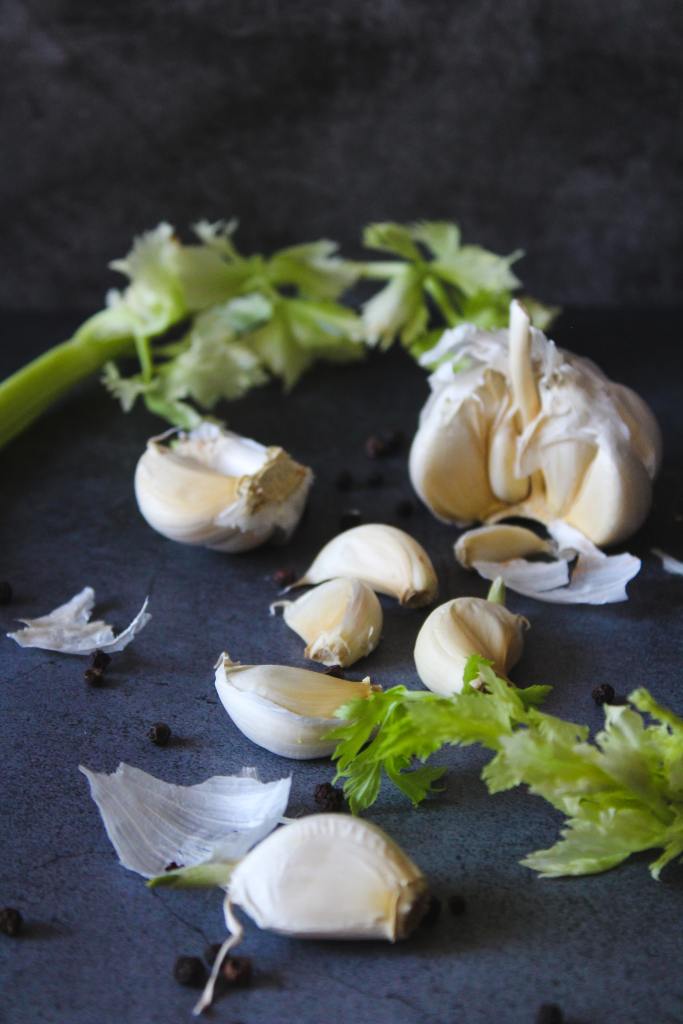Listen on Spotify.
Wild garlic is a favourite springtime treat for many people. It is a bulbous, leafy green plant native to Britain. Early shoots start to appear in mid-February, and it flowers in April. It flourishes in woodland, usually near a water source. It has become a popular ingredient in recent years. It signals the beginning of spring.
It’s a versatile plant and you can enjoy every part of it. It can be used in several recipes, even the seeds can be picked and used when wild garlic is not in season. Thus, it’s a wonderful plant to include in your garden.
In the rest of this piece, I’ll give you tips on how to grow wild garlic and share some ideas about what delicious dishes you can create using it. First, though, let’s find out a bit more about this plant.
Let’s get into it.
When is wild garlic in season?
In mid-February, you will see the first tender shoots start to appear, and in late March you will find the signature leafy green bulbous plant. But this plant has one last surprise in store. It will flower in April and the beautiful star-shaped bloom can grace any salad. In early June, the leaves become bitter, and the plant goes to seed. You can still eat the seeds raw or pickled.
How you can identify wild garlic
Typically, you’ll find wild garlic on the borders of woodland, in patches of shade near streams and brooks. It grows in abundance, and you can find entire gullies carpeted with wild garlic.
Wild garlic exudes an unmistakable aroma, an oniony smell that’s not dissimilar to chives. The leaves of the plant are wide and pointed. It produces a white, star-shaped bloom that looks like a snowdrop. You can pick wild garlic if you ask the permission of the landowner first. It remains illegal to dig wild garlic out of common ground.

Which parts of the plant can you eat?
The great thing about wild garlic is that you can eat the entire plant, either cooked or raw. The bulb that grows underground can be eaten like an onion. The larger leaves can be cooked in the same way as spinach. Alternatively, you can eat them raw. You can use the early shoots can be used as a herb, as can the stem of the plant. The flowers can serve as a garnish and the seeds can also be added to salads.
What you need to pick wild garlic
If you want to gather wild garlic, you’ll need:
- Permission from the landowner if you want to dig up the bulbs.
- Footwear you don’t mind getting muddy.
- Scissors.
- A basket.
- A gardening trowel.
All you need to do to collect the plant is to snip the whole plant or just the leaves with a pair of scissors.
Be aware that there are a couple of poisonous plants you could mistake for wild garlic if you’re not careful. Lords and Ladies both look like wild garlic, but both are poisonous. The big clue is in the scent. No other plant will have the aroma of wild garlic. If you’re foraging for the first time, it might be a good idea to take someone with more experience along with you. Never consume anything you’re unsure of.
When picked, it is best stored in a cool, dark place. The flowers should be used on the day foraged, but the leaves should keep for 3-4 days.
Don’t fancy foraging for it but would still like to have some of it on hand?
It’s the perfect time to explore what potential there is to grow it in your garden. Then you can decide if you want to add it to the list of vegetables that I shared with you in an earlier post.
How to grow wild garlic
Before I go through the steps of growing it, let’s talk about the perfect growing conditions for this plant.
Wild garlic will regrow each year if you plant it in your garden just once. You can put this plant in partial or full shade. It’s good for it because it usually grows in damp shaded areas of woodland. Indeed, the more shade there is, the longer its growing season will be. It will grow best in moisture-retentive soil.
You have two choices when growing wild garlic, you can either grow it directly from seed or plant bulbs of it in your garden. If you want some wild garlic fast, plant bulbs and you will be able to harvest some a year after planting.
Growing wild garlic from seed takes longer. It will be four years before you can harvest from it. Seeds a cheaper than bulbs, so it’s the way to go if you want to go the inexpensive route and are prepared to wait a while to enjoy the fruits of your labour.
Growing wild garlic in pots from seed
If you want to start by growing garlic in pots, you should sow the seeds in March.
It’s a straightforward process.
- Fill 9cm pots with compost.
- Dampen the soil with water.
- Put a few garlic seeds in each pot and ensure you evenly space them out.
- Cover the seeds with another 1cm of compost.
- Place the pots somewhere warm, between 15 and 20°C, making sure that you’ve watered them lightly.
The seeds will take around a week to germinate. After germination, you’ll need to make sure that the soil is kept constantly damp and gets enough light. The seeds will need another month inside before you can move them outdoors.
Direct sowing
Wild garlic seeds can be sown directly into the ground at any point from October to June, provided it isn’t frozen. Follow these steps.
- Mix fertiliser or organic material into the soil of your planting area to prepare and enrich it. It will also make the soil more water retentive.
- Sow the seeds 1cm deep, and keep them at least 5cm apart.
- Cover them and then water them. Make sure you keep the soil moist, and you’ll soon see green shoots begin to appear.
Planting wild garlic bulbs
If you choose to plant bulbs, you should do so in early spring for the best results, as the plants have time to spread and grow a network of roots before the arrival of cold weather.
- Plant the bulbs 3cm deep, and about 7cm apart.
- Water them after they are planted and take care not to let them dry out.
Growing it in a greenhouse
There is no reason that wild garlic cannot thrive in a greenhouse, but it may die sooner because of the higher temperatures. However, you’ll be able to harvest it earlier.
- Make sure it has plenty of shade.
- If you’re growing it in pots, to make sure it doesn’t take over your entire greenhouse, all you’ll need is pots that are about 20cm deep, compost, and the ability to water your plants often.
Caring for wild garlic
Luckily, wild garlic doesn’t need a lot of care. If you’ve planted your garlic outdoors, you will only have to water it if there is a long dry spell. Similarly, if the seeds are sown in rich, fertile soil, you don’t need to add fertiliser. You can just add some compost each spring to add nutrients to the soil. Even this isn’t necessary.
Sometimes, newly planted seedlings will struggle to grow if you have a lot of weeds. Therefore, you need to weed the area around your garlic seeds often. You can mulch your wild garlic in early spring to reduce the amount of weeding you’ll have to do.
Problems you might encounter
The smell garlic exudes ensures you’ll seldom have a problem with pests. Diseases aren’t usually a problem either, thanks to this plant’s hardy nature. There are a couple worth watching out for though.
Onion Rot – This disease causes stems and bulbs to soften and become mushy. Plants infected will need to be removed, as will a portion of the soil around them. This disease specifically targets plants of the alum family.
Rust – This is a fungal wind-borne uncurable disease that can cause the plant to die. Early signs of it include stunted growth and yellowing leaves. If your plant becomes infected, all of it should be removed, along with any debris it sheds.
Harvesting wild garlic
The most harvested part of wild garlic is the leaves. They are best harvested when they are a vibrant green before the plant begins to flower. Usually, this works out to be between March and June.
You can cut the leaves off with a knife or pick them by hand. Either way, it’s important to do so as close to the ground as you can. Pick the healthiest, large leaves and place them carefully in a basket or bag to avoid bruising them. By leaving smaller leaves alone, you allow the plant to continue growing.
If you want to harvest the flowers that will begin to appear in April, you can snip them off their stem with scissors. You can eat the sweet-tasting stems as well if you wish.
Before wrapping up, I’ll share some ideas on how you might use your beautiful homegrown garlic.

Cooking with wild garlic
You can create lots of delicious snacks and meals if you use wild garlic as an ingredient. You should wash it in cold water before using it, to get rid of mud and any insects that might be lurking.
Here are some ideas on what to make with your newly harvested garlic.
Wild garlic pesto
Put wild garlic leaves in a blender with pine nuts, parmesan, garlic and lemon and blitz to make a rough paste. This is scrumptious when stirred through pasta or drizzled over soups and salads. You can keep it in your fridge for about a fortnight.
Garlic butter
Mash together a bunch of wild garlic, some butter, and a pinch of sea salt and hey presto, you’ve got garlic butter. You can chill it for about a month and use it to enhance jacket potatoes or make delicious garlic bread. You could even use it to make Chicken Kiev.
Spatchcock Chicken
Mix wild garlic with lemon juice and Greek yoghurt to make labneh. This will serve as an ideal accompaniment to spiced roast chicken with chickpeas.
Add flair to new potatoes
Toss cooked new potatoes with chopped parsley, wild garlic, and mustard to give them a bit of a makeover for special occasions.
Take Sunday lunch to the next level
Mix wild garlic with nutmeg, sourdough breadcrumbs and herbs. Cut a flap along a rack of pork and rub the mixture into it. This will let the meat take on the delectable flavours and is sure to be a crowd-pleaser.
Wrapping up
Not much can be harvested in early spring, so wild garlic might prove a wonderful addition to your garden. You might even have the confidence to go and forage for it after reading this. If not, you can follow the tips for growing your own and may even be inspired to try making delicious homemade pesto with it when it’s harvested.
Who knows? Your garlic bread made with homemade garlic butter may soon be the talk of the neighbourhood!

One thought on “Wild Garlic and How to Grow It”